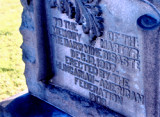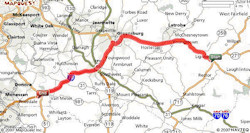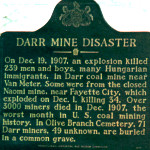 Commemorating
the 100th Anniversary of the Darr Mine Disaster in Pennsylvania. On
December 19, 1907 an explosion in the Darr Mine took the lives of
239 men and teenage boys as young as 14. Most of those killed were
Hungarian immigrant laborers. AHF, five member organizations, and
others have joined forces to help ensure they are not forgotten.
Commemorating
the 100th Anniversary of the Darr Mine Disaster in Pennsylvania. On
December 19, 1907 an explosion in the Darr Mine took the lives of
239 men and teenage boys as young as 14. Most of those killed were
Hungarian immigrant laborers. AHF, five member organizations, and
others have joined forces to help ensure they are not forgotten.
[ invitation in English] [
invitation in English] [ meghivó magyarul] [download
the fact sheet]
meghivó magyarul] [download
the fact sheet]
 WHEN
WHEN
September 29, 2007; 11:00 a.m.
WHERE
Olive Branch Baptist Church and Cemetery
981 State Route
Van Meter, PA 15012
PROGRAM (Subject to Change)
- Opening prayers
- American and Hungarian National Anthems
- Remarks by Representatives of the Sponsors, Federal, State
and Local Officials, Union Representatives
- Wreath laying ceremony at the cemetery
- Reception and Lunch (at Belle Vernon Holiday Inn)
- Visit to Darr Mine site (Optional)
For more details, directions, and accomodations, [download
the FACT SHEET]
Numerous organizations have joined forces to help us
remember this important occasion. such as The
Bethlen Home, The
William Penn Association, the Hungarian
Reformed Federation of America,
The Calvin Synod and Hungarian Reformed Church, and the Rostraver
Township Historical Society.
Sponsoring organizations issued a joint statement, saying,
""By remembering the Darr tragedy, we reaffirm our nation's
focus on safety in the workplace..." "We affirm that the
sacrifices were not in vain, and we pledge ourselves to continue working
together for the good of humankind."
Please contact Rev. Imre Bertalan, Jr. of the Bethlen
Home and get involved! [revimre@bethlen.com]
or (724) 238-2235





About the Darr Mine Disaster
The Darr Mine Disaster is known as the second worst in US history
and the worst in Pennsylvania history. On December 19, 1907 a gas
and dust explosion killed 239 coal miners in the dark tunnels of the
Darr Mine near Rostraver Township in Western Pennsylvania. The majority
of the dead were Hungarian immigrant laborers. December 1907 would
go on to be The
Deadliest Month in US Mining History.
The month began with an explosion that killed all 34 miners inside
the Naomi Mine in Fayette County on Dec. 1. Five days later, the single
greatest mine disaster in American history occurred when massive explosions
and roof collapses killed 362 men in Monongah, West Va. Ten days later,
on Dec.16, an explosion in the Yolanda, Ala. killed 57 miners, many
by asphyxiation. By the time this deadly month ended, more than 3,200
American miners had died in accidents. In Pennsylvania, 1,400 miners
died that year, 708 in the Anthracite mines, and 806 in the Bituminous
fields.
Why so many Hungarians?
The total dead at Darr could have been much higher, eclipsing even
the Monangah disaster, if not for the fact that many of the miners
were recent immigrants of the Orthodox faith which celebrates the
Feast of St. Nicholas on December 19 according to the Julian calendar.
As a result, nearly 200 miners chose not to go to work the day the
explosion happened. Those that chose to work that day were mostly
Hungarian immigrants.
Honoring the Dead
The American Hungarian Federation (then known as the Hungarian American
Federation) placed the memorial seen here in 1909. An inquiry into
the disaster afterwards concluded, as was usually the case in that
period of Pennsylvania coal mining, that the Pittsburgh Coal Company
was not at fault.
Pete Starry, a mining historian, provided an interesting article
to the The Coal Miner's Memorial. It was The United Mine Workers Journal
from Dec. 1, 1957, entitled, "Main Thing was Management Neglect:"
"All of the mining disasters of December, 1907 had several
things in common. The main thing was management neglect and insome
cases brutal criminal negligence. Black powder was used for blasting
in all of these stricken mines. Coal dust was allowed to accumulate
in spite of warnings from England that it was highly explosive.
All of the mines were gassy and seem to have been poorly ventilated.
It is quite possible that the Jacobs Creek disaster would not have
taken place if the men had been allowed by Providence one more day
to dig out 40 feet of coal to reach a new shaft the company had
sunk in an effort to improve ventilation in the mine.
One of the victims of the explosion was a mine foreman, H.S. Campbell.
His widow reported that his main preoccupation and worry in the
months preceeding the blast was with the gassy condition and poor
ventilation in the Darr Mine. He pestered the company about it and
it was at his urging that the new ventilating shaft had been sunk.
Campbell's worry, which made him tell his wife he could not even
think about Christmas, goaded the company into action, but it was
24 hours too late for 239 men."
But the miners did not die
in vain...
The PA EPA wrote: "The Darr and Monongha disasters marked the
first use of self-contained breathing apparatus in a deep-mine rescue
in the United States. Other major advances in mine safety followed
soon after. Within six months the U.S. Geological Survey created the
Mine Accidents Division and opened a station devoted to research of
mine rescue techniques in Pittsburgh. In two years, branch stations
were established in Illinois, Tennessee and Washington. And on July
1, 1910 an Act of Congress established the U.S. Bureau of Mines.
The following year, the number of mining fatalities began to drop,
and never again approached the horrific total of 1907. In 1954, the
number of mining fatalities dropped below 100 for the first time since
mining began in Pennsylvania. Although deep mining remains a dangerous
occupation, advances in knowledge, equipment and regulations have
combined to make Pennsylvania's Deep Mine Safety program a national
model." [read
more]
 In
September 1994, the Pennsylvania Historical & Museum Commission
placed a Historic Site Marker honoring the coal miners killed
in the Darr Mine Explosion, Dec. 19, 1907. The plaque is located at
the Olive Branch Cemetery, on PA Route 981 between PA Route 51 and
Smithton, PA. The marker was not erected until September 1994.
In
September 1994, the Pennsylvania Historical & Museum Commission
placed a Historic Site Marker honoring the coal miners killed
in the Darr Mine Explosion, Dec. 19, 1907. The plaque is located at
the Olive Branch Cemetery, on PA Route 981 between PA Route 51 and
Smithton, PA. The marker was not erected until September 1994.
The plaque reads as follows:
"On December 19, 1907, an explosion killed 239 men and boys,
many Hungarian immigrants, in Darr coal mine near Van Meter. Some
were from the closed Naomi mine near Fayette City, which exploded
on Dec. 1, killing 34. Over 3000 miners died in Dec. 1907, the worst
month in U. S. coal mining history. In Olive Branch Cemetery, 71 Darr
miners, 49 unknown, are buried in a common grave."
Strength
can only be found in unity! Please join AHF and work
together on common ground issues!
There are two easy ways to Join
and Support us!
1) Online Processing (fastest):

Join online! AHF accepts all
major credit cards and checks. AHF is a 501c(3) non-profit organization.
Your donations may be tax deductible. Your information is secure
not shared with anyone. [Join
Online Here]
2) The Old-Fashioned Way:
If you are uncomfortable or unable to process an Internet transaction,
download the AHF
Membership Registration Form and mail it in with your check payable
to "American Hungarian Federation." NOTE: If you are sending
a donation for a specific fund, please be sure to include that on
the form. (You do not need to become a member to donate):
American Hungarian Federation
C/O Sandor Murray, Treasurer
2805 56th Place
Woodside NY 11377
For technical assistance, contact bryandawson@americanhungarianfederation.org
[ >
GO to all AHF news]
PRIVACY NOTICE: AHF will not share
its mailing list with anyone...Period. AHF also uses this list SPARINGLY.
DISCLAIMER: The American Hungarian
Federation does not necessarily endorse the content or opinions found
in the external sites found this eNewsletter or those expressed by
its individual members and member organizations...
© 2007 American Hungarian Federation, All Rights
Reserved










